小学英语一般现在时的句型结构(1)
- 格式:doc
- 大小:15.50 KB
- 文档页数:1
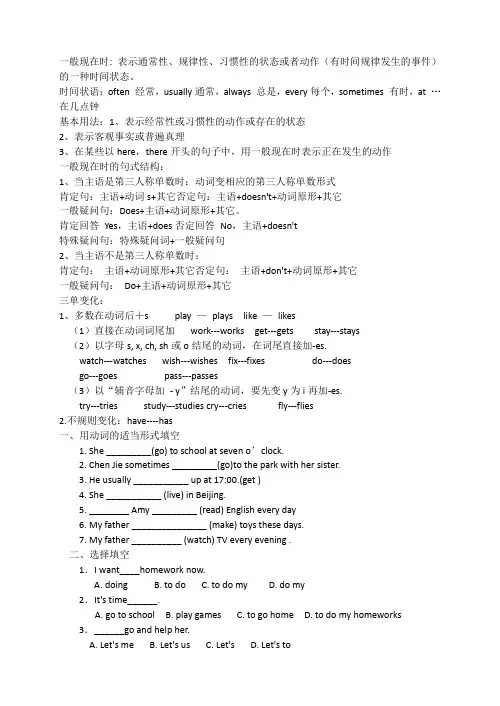
一般现在时: 表示通常性、规律性、习惯性的状态或者动作(有时间规律发生的事件)的一种时间状态。
时间状语:often 经常,usually通常,always 总是,every每个,sometimes 有时,at …在几点钟基本用法:1、表示经常性或习惯性的动作或存在的状态2、表示客观事实或普遍真理3、在某些以here,there开头的句子中,用一般现在时表示正在发生的动作一般现在时的句式结构:1、当主语是第三人称单数时:动词变相应的第三人称单数形式肯定句:主语+动词s+其它否定句:主语+doesn't+动词原形+其它一般疑问句:Does+主语+动词原形+其它。
肯定回答Yes,主语+does否定回答No,主语+doesn't特殊疑问句:特殊疑问词+一般疑问句2、当主语不是第三人称单数时:肯定句:主语+动词原形+其它否定句:主语+don't+动词原形+其它一般疑问句:Do+主语+动词原形+其它三单变化:1、多数在动词后+s play —plays like —likes(1)直接在动词词尾加work---works get---gets stay---stays(2)以字母s, x, ch, sh或o结尾的动词,在词尾直接加-es.watch---watches wish---wishes fix---fixes do---doesgo---goes pass---passes(3)以“辅音字母加- y”结尾的动词,要先变y为i再加-es.try---tries study---studies cry---cries fly---flies2.不规则变化:have----has一、用动词的适当形式填空1. She _________(go) to school at seven o’clock.2. Chen Jie sometimes _________(go)to the park with her sister.3. He usually ___________ up at 17:00.(get )4. She ___________ (live) in Beijing.5. ________ Amy _________ (read) English every day6. My father _______________ (make) toys these days.7. My father __________ (watch) TV every evening .二、选择填空1.I want____homework now.A. doingB. to doC. to do myD. do my2.It's time______.A. go to schoolB. play gamesC. to go homeD. to do my homeworks3.______go and help her.A. Let's meB. Let's usC. Let'sD. Let's to4.Do they have a new car Yes,_____.A .they are have C. they don't D. they do5.He often _________ supper at 6:00 in the evening.A. haveB. has c. is having D. is eating6. We _____________ any Chinese classes on Friday.A. are havingB. aren’t havingC. don’t haveD. are have三、用括号内动词的适当形式填空。
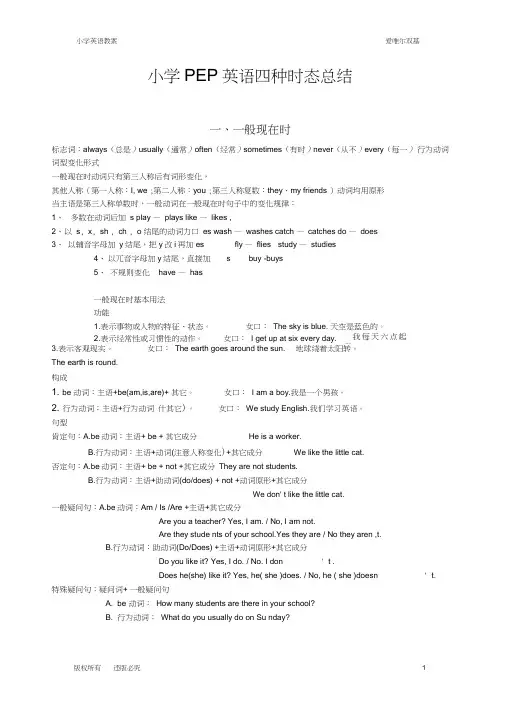
小学PEP英语四种时态总结一、一般现在时标志词:always(总是)usually(通常)often(经常)sometimes(有时)never(从不)every(每一)行为动词词型变化形式一般现在时动词只有第三人称后有词形变化,其他人称(第一人称:I, we ;第二人称:you ;第三人称复数:they、my friends )动词均用原形当主语是第三人称单数时,一般动词在一般现在时句子中的变化规律:1、多数在动词后加s play —plays like —likes ,2、以s, x, sh , ch , o 结尾的动词力口es wash —washes catch —catches do —does3、以辅音字母加y结尾,把y改i再加es fly —flies study —studiess buy -buys4、以兀音字母加y结尾,直接加5、不规则变化have —has一般现在时基本用法功能1.表示事物或人物的特征、状态。
女口:The sky is blue. 天空是蓝色的。
2.表示经常性或习惯性的动作。
女口:I get up at six every day. 我每天六点起床。
3.表示客观现实。
女口:The earth goes around the sun. 地球绕着太阳转。
The earth is round.构成1. be 动词:主语+be(am,is,are)+ 其它。
女口:I am a boy.我是一个男孩。
2. 行为动词:主语+行为动词什其它)。
女口:We study English. 我们学习英语。
句型肯定句:A.be动词:主语+ be + 其它成分He is a worker.B.行为动词:主语+动词(注意人称变化)+其它成分We like the little cat.否定句:A.be动词:主语+ be + not +其它成分They are not students.B.行为动词:主语+助动词(do/does) + not +动词原形+其它成分We don' t like the little cat.一般疑问句:A.be动词:Am / Is /Are +主语+其它成分Are you a teacher? Yes, I am. / No, I am not.Are they stude nts of your school.Yes they are / No they aren ,t.B.行为动词:助动词(Do/Does) +主语+动词原形+其它成分Do you like it? Yes, I do. / No. I don ' t .Does he(she) like it? Yes, he( she )does. / No, he ( she )doesn ' t.特殊疑问句:疑问词+ 一般疑问句A. be 动词:How many students are there in your school?B. 行为动词:What do you usually do on Su nday?一般现在时动词 be 和have 的变化形式 1. 动词Be 叫连系动词,用法:第一人称单数用 am ,第三人称单数用is ,其它人称用are 。
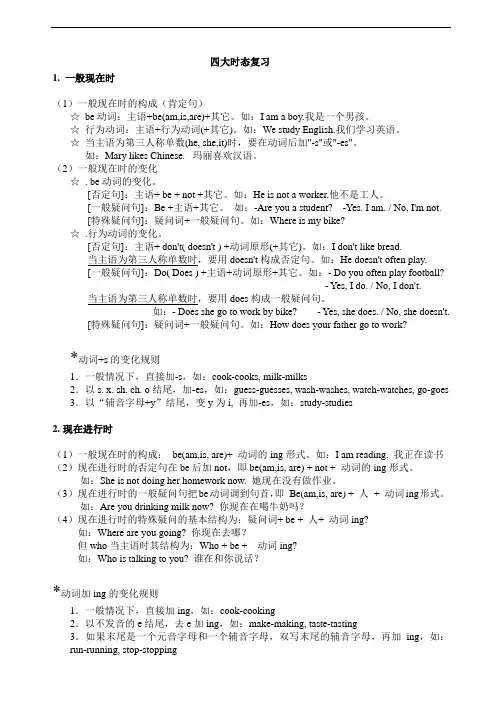
四大时态复习1. 一般现在时(1)一般现在时的构成(肯定句)☆be动词:主语+be(am,is,are)+其它。
如:I am a boy.我是一个男孩。
☆行为动词:主语+行为动词(+其它)。
如:We study English.我们学习英语。
☆当主语为第三人称单数(he, she,it)时,要在动词后加"-s"或"-es"。
如:Mary likes Chinese. 玛丽喜欢汉语。
(2)一般现在时的变化☆. be动词的变化。
[否定句]:主语+ be + not +其它。
如:He is not a worker.他不是工人。
[一般疑问句]:Be +主语+其它。
如:-Are you a student? -Yes. I am. / No, I'm not.[特殊疑问句]:疑问词+一般疑问句。
如:Where is my bike?☆.行为动词的变化。
[否定句]:主语+ don't( doesn't ) +动词原形(+其它)。
如:I don't like bread.当主语为第三人称单数时,要用doesn't构成否定句。
如:He doesn't often play.[一般疑问句]:Do( Does ) +主语+动词原形+其它。
如:- Do you often play football?- Yes, I do. / No, I don't.当主语为第三人称单数时,要用does构成一般疑问句。
如:- Does she go to work by bike? - Yes, she does. / No, she doesn't.[特殊疑问句]:疑问词+一般疑问句。
如:How does your father go to work?*动词+s的变化规则1.一般情况下,直接加-s,如:cook-cooks, milk-milks2.以s. x. sh. ch. o结尾,加-es,如:guess-guesses, wash-washes, watch-watches, go-goes 3.以“辅音字母+y”结尾,变y为i, 再加-es,如:study-studies2.现在进行时(1)一般现在时的构成:be(am,is, are)+ 动词的ing形式。
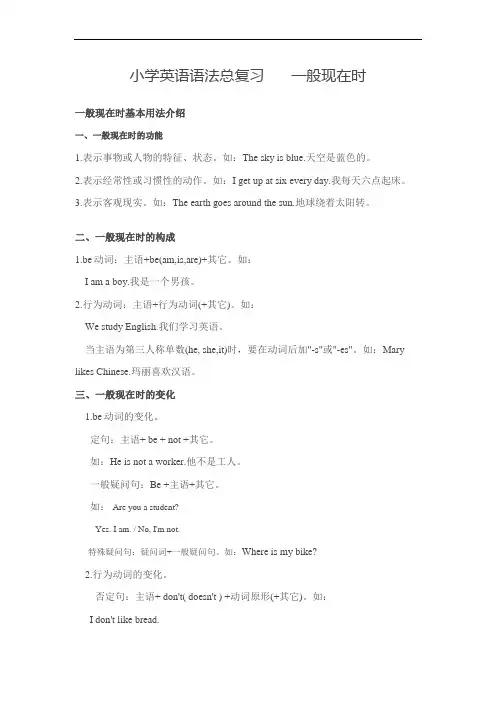
小学英语语法总复习一般现在时一般现在时基本用法介绍一、一般现在时的功能1.表示事物或人物的特征、状态。
如:The sky is blue.天空是蓝色的。
2.表示经常性或习惯性的动作。
如:I get up at six every day.我每天六点起床。
3.表示客观现实。
如:The earth goes around the sun.地球绕着太阳转。
二、一般现在时的构成1.be动词:主语+be(am,is,are)+其它。
如:I am a boy.我是一个男孩。
2.行为动词:主语+行为动词(+其它)。
如:We study English.我们学习英语。
当主语为第三人称单数(he, she,it)时,要在动词后加"-s"或"-es"。
如:Mary likes Chinese.玛丽喜欢汉语。
三、一般现在时的变化1.be动词的变化。
定句:主语+ be + not +其它。
如:He is not a worker.他不是工人。
一般疑问句:Be +主语+其它。
如:-Are you a student?-Yes. I am. / No, I'm not.特殊疑问句:疑问词+一般疑问句。
如:Where is my bike?2.行为动词的变化。
否定句:主语+ don't( doesn't ) +动词原形(+其它)。
如:I don't like bread.当主语为第三人称单数时,要用doesn't构成否定句。
如:He doesn't often play.一般疑问句:Do( Does ) +主语+动词原形+其它。
如:- Do you often play football?- Yes, I do. / No, I don't.当主语为第三人称单数时,要用does构成一般疑问句。
如:- Does she go to work by bike?- Yes, she does. / No, she doesn't.特殊疑问句:疑问词+一般疑问句。

小学最全英语语法汇总一、时态1.一般现在时(1)表示经常发生的动作或事情,通常用“usually 通常, often常常, every…每…, sometimes有时,always总是,”等词。
(2)基本结构:I / You / We /TheyHe / She / It肯定句动词原形动词第三人称单数形式否定句don’t + 动原doesn’t + 动原一般疑问句(Yes/No) Do… ? Yes, Ido.Does…(动词原形)…?No,she doesn’t.特殊疑问句What do …? How does she…(动词原形)…?(3) 动词第三人称单数形式(同名词单数变成复数方法相同)1 一般情况+s 如:walk-walks2. 辅音字母+y结尾去y +ies f ly-flies3. 结尾是 s, x, sh, ch +es watch-watches4.特殊的do-does ,have-has, go-goes2.现在进行时,(1)表示正在发生的动作,通常用“now现在, look 看,linsen听”.(2)基本形式: be + 动词ingeg: I am(not) doing my homework.You/We/They are(not) reading.He/She/It is(not) eating.What are you doing?Is he reading?(3)动词的现在分词形式(动词+ing)一般情况+ing walk—walking结尾是不发音的 e -e +ingcome—coming重读闭音节双写最后一个字母+ing run-running swim-swimming3. 一般过去时(1)表示过去已经发生的事情,通常用“last …上一个…, just now刚才, a moment ago刚才,yesterday 昨天”等词。
(2) be 动词的过去式: am/is —was are —were(3)过去式基本结构 肯定句(Positive )动词过去式 I went shopping lastnight. 否定句(Negative) Didn ’t + 动词原形I didn ’t go shoppinglast night. 一般疑问句(Yes/No) Did …+ 动词原形…? Did you go shopping last night?特殊疑问句(wh-) What did …+ 动词原形…? What did you do last night?(4)词过去式的变化:规则动词的变化:一般动词 +ed planted,watered,climbed以不发音的e 结尾+d liked 辅音字母加y 结尾 -y+ ied study —studied,cry- cried重读闭音节单词,末尾只有一个辅音字母 双写最后一个字母+edstop –stopped plan - planned不规则动词的变化:原形 过去式 原形 过去式 原形 过去式 原形 过去式sweep swept t each taught have had go wentkeep kept think thought do did find foundsleep slept b uy bought eat ate say saidfeelfelt drink drank is/am w as take took readread give gave are were mean meant putput sing sang drive d rove meet met cutcut begin began speak s poke make made letlet ring rang write w rote see saw flyflew run ran ride rode come came drawdrew sit sat hear heard tell told grow grew learn learned/ learntget got know knew 4.一般将来时一般将来时表示将来打算做的事或将要发生的事情。
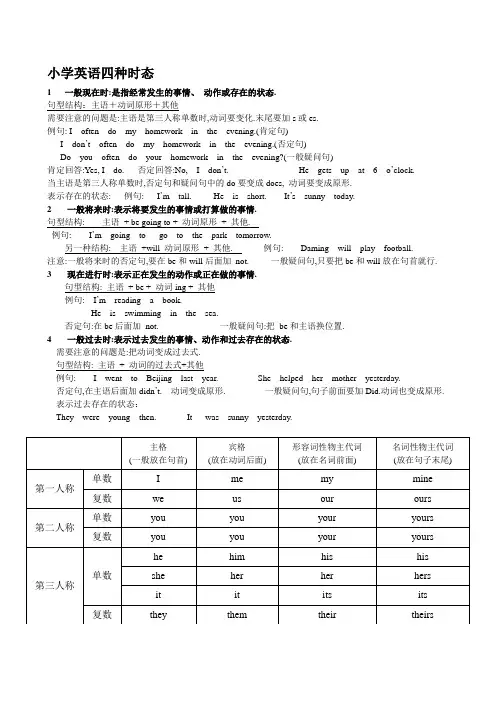
小学英语四种时态1一般现在时:是指经常发生的事情、动作或存在的状态.句型结构:主语+动词原形+其他需要注意的问题是:主语是第三人称单数时,动词要变化.末尾要加s或es.例句: I often do my homework in the evening.(肯定句)I don’t often do my homework in the evening.(否定句)Do you often do your homework in the evening?(一般疑问句)肯定回答:Yes, I do. 否定回答:No, I don’t. He gets up at 6 o’clock.当主语是第三人称单数时,否定句和疑问句中的do要变成does, 动词要变成原形.表示存在的状态: 例句: I’m tall. He is short. It’s sunny today.2一般将来时:表示将要发生的事情或打算做的事情.句型结构: 主语+ be going to + 动词原形+ 其他.例句: I’m going to go to the park tomorrow.另一种结构: 主语+will 动词原形+ 其他. 例句: Daming will play football.注意:一般将来时的否定句,要在be和will后面加not. 一般疑问句,只要把be和will放在句首就行. 3现在进行时:表示正在发生的动作或正在做的事情.句型结构: 主语+ be + 动词ing + 其他例句: I’m reading a book.He is swimming in the sea.否定句:在be后面加not. 一般疑问句:把be和主语换位置.4一般过去时:表示过去发生的事情、动作和过去存在的状态.需要注意的问题是:把动词变成过去式.句型结构: 主语+ 动词的过去式+其他例句: I went to Beijing last year. She helped her mother yesterday.否定句,在主语后面加didn’t. 动词变成原形. 一般疑问句,句子前面要加Did.动词也变成原形.表示过去存在的状态:They were young then. It was sunny yesterday.。
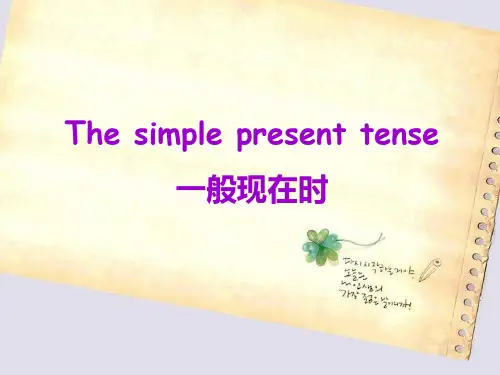
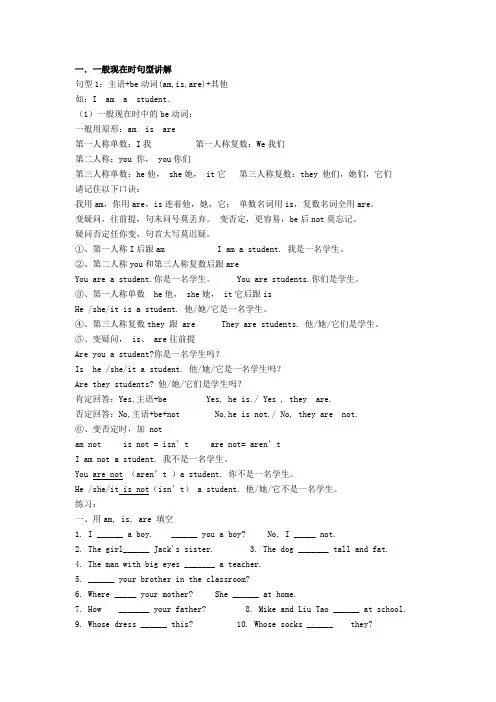
一.一般现在时句型讲解句型1:主语+be动词(am,is,are)+其他如:I am a student.(1)一般现在时中的be动词:一般用原形:am is are第一人称单数:I我第一人称复数:We我们第二人称:you 你, you你们第三人称单数:he他, she她, it它第三人称复数:they 他们,她们,它们请记住以下口诀:我用am,你用are,is连着他,她,它;单数名词用is,复数名词全用are。
变疑问,往前提,句末问号莫丢弃。
变否定,更容易,be后not莫忘记。
疑问否定任你变,句首大写莫迟疑。
①、第一人称I后跟am I am a student. 我是一名学生。
②、第二人称you和第三人称复数后跟areYou are a student.你是一名学生。
You are students.你们是学生。
③、第一人称单数 he他, she她, it它后跟isHe /she/it is a student. 他/她/它是一名学生。
④、第三人称复数they 跟 are They are students. 他/她/它们是学生。
⑤、变疑问, is、 are往前提Are you a student?你是一名学生吗?Is he /she/it a student. 他/她/它是一名学生吗?Are they students? 他/她/它们是学生吗?肯定回答:Yes,主语+be Yes, he is./ Yes , they are.否定回答:No,主语+be+not No,he is not./ No, they are not.⑥、变否定时,加 notam not is not = isn’t are not= aren’tI am not a student. 我不是一名学生。
You are not (aren’t )a student. 你不是一名学生。
一、用am, is, are 填空1. I ______ a boy. ______ you a boy? No, I _____ not.2. The girl______ Jack's sister.3. The dog _______ tall and fat.4. The man with big eyes _______ a teacher.5. ______ your brother in the classroom?6. Where _____ your mother? She ______ at home.7. How _______ your father? 8. Mike and Liu Tao ______ at school.9. Whose dress ______ this? 10. Whose socks ______ they?11. That ______ my red skirt. 12. Who ______ I ?13.The jeans ______ on the desk. 14.Here ______ a scarf for you.15. Here ______ some sweaters for you. 16. The two cups of milk _____ for me.17. Some tea ______ in the glass. 18. Gao shan's shirt _______ over there. 19. My sister's name ______ Nancy. 20. This ______ not Wang Fang's pencil.21. ______ David and Helen from England?22. You, he and I ______ from China.3) She is always a good student. (改为一般疑问句并作出肯定回答)--- ______ she always a good student?--- ______ , ______ ______ .(1)一般情况下,直接在基数词后面加th(one , two , three 除外)。
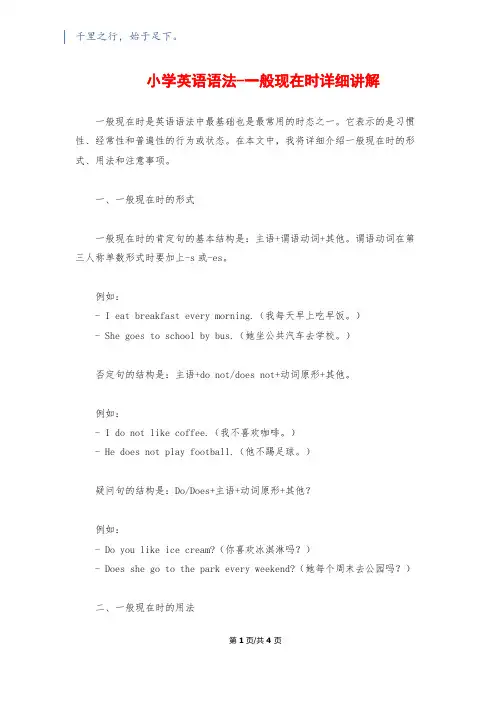
小学英语语法-一般现在时详细讲解一般现在时是英语语法中最基础也是最常用的时态之一。
它表示的是习惯性、经常性和普遍性的行为或状态。
在本文中,我将详细介绍一般现在时的形式、用法和注意事项。
一、一般现在时的形式一般现在时的肯定句的基本结构是:主语+谓语动词+其他。
谓语动词在第三人称单数形式时要加上-s或-es。
例如:- I eat breakfast every morning.(我每天早上吃早饭。
)- She goes to school by bus.(她坐公共汽车去学校。
)否定句的结构是:主语+do not/does not+动词原形+其他。
例如:- I do not like coffee.(我不喜欢咖啡。
)- He does not play football.(他不踢足球。
)疑问句的结构是:Do/Does+主语+动词原形+其他?例如:- Do you like ice cream?(你喜欢冰淇淋吗?)- Does she go to the park every weekend?(她每个周末去公园吗?)二、一般现在时的用法第1页/共4页1. 表示习惯或经常性的动作:- I write in my diary every night.(我每天晚上写日记。
)- They play basketball every Sunday.(他们每个星期天打篮球。
)2. 表示客观事实、自然规律或科学真理:- Water boils at 100 degrees Celsius.(水在100摄氏度时煮沸。
)- The sun rises in the east.(太阳从东方升起。
)3. 表示感觉、想法和喜好:- I love chocolate.(我喜欢巧克力。
)- He hates to wake up early.(他讨厌早起。
)4. 表示现时状态或现时临时的动作:- I am a student.(我是一个学生。
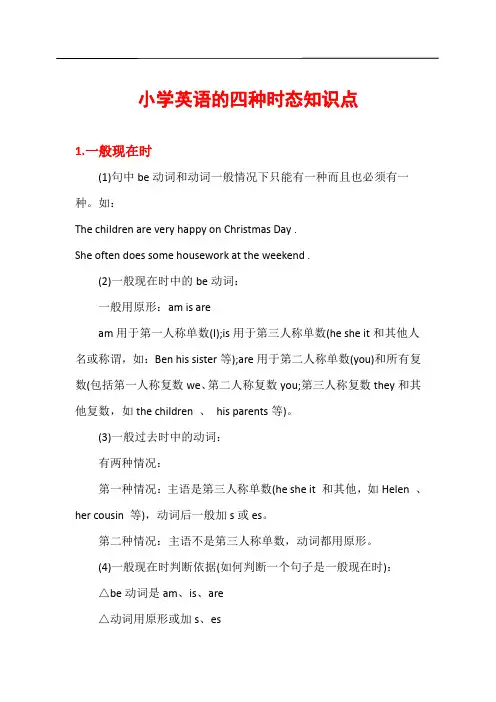
小学英语的四种时态知识点1.一般现在时(1)句中be动词和动词一般情况下只能有一种而且也必须有一种。
如:The children are very happy on Christmas Day .She often does some housework at the weekend .(2)一般现在时中的be动词:一般用原形:am is aream用于第一人称单数(I);is用于第三人称单数(he she it和其他人名或称谓,如:Ben his sister等);are用于第二人称单数(you)和所有复数(包括第一人称复数we、第二人称复数you;第三人称复数they和其他复数,如the children 、his parents等)。
(3)一般过去时中的动词:有两种情况:第一种情况:主语是第三人称单数(he she it 和其他,如Helen 、her cousin 等),动词后一般加s或es。
第二种情况:主语不是第三人称单数,动词都用原形。
(4)一般现在时判断依据(如何判断一个句子是一般现在时):△be动词是am、is、are△动词用原形或加s、es△没有时间状语或有usually、often、everyday、sometimes等不是具体的时间(5)有用的的依据:Be动词是is、am ←→名词用原形(这里包括可数名词的单数和不可数名词)Be动词是are ←→名词加s或es动词加s或es ←→主语是第三人称单数动词用原形←→主语不是第三人称单数(6)情态动词:我们现在学过的情态动词有:can、must、should、would。
情态动词后动词总是用原形。
(不受其他任何条件影响)2.一般过去时(1)句中be动词和动词一般情况下只能有一种而且也必须有一种。
如:The girls were on the grass just now .They visited my parents last weekend .(2)一般过去时中的be动词:一般用过去式:was werewas用于第一人称单数(I)和第三人称单数(he she it和其他人名或称谓,如:Ben 、his sister等);were用于第二人称单数(you)和所有复数(包括第一人称复数we、第二人称复数you;第三人称复数they 和其他复数,如the children 、his parents等)。

【知识梳理1】般现在时的构成:1. be动词:主语+ be +其他宀注意:be动词根据人称相应地变化为am, is areHe is a little boy.eg: I am a little boy.She is a little girl.2. 行为动词:主语+行为动词+其他T注意:当主语为第三人称单数(he, she, it)时,要在动词后加’-s/I/They/You/We study En glish.eg:He/She studies En glish.般现在时基本使用情况:1. 表示经常性或习惯性的动作:I get up at six every day.关键词:常与表示频率的时间副词连用2. 表示事物和人物的特征、状态:The sky is blue. He is fat.1. Fill in the bla nks with the give n verbs in their proper forms.I.She usually ______ (go) to school by bike.2. The sun ____ (rise) in the east and _______ (set) in the west .3. Joh n and Linda ________ in the same class. (be)4. _________ your schoolbags in Room 301? (be)5. _________ he often __________his homework every morning? (do)6. We ________ TV on Mon day. (not watch)7. ________ your mother __________rooms every day? (clea n)es ' oI dayyearweek every me nthafter noon evening , usuallyalwayson ce/twice/three times aweekon Sundayson Mon days3.表示客观事实:【巩固练习】The earth goes around the sun.【巩固练习】I. 选择最恰当的答案)1. you have a book?A. DoB. AreC. IsD. Have)2. They on a farm.A. workingB. is workC. workD. is worked)3. ---- Does Peter like to watch TV?A. Yes, he likes )4. She doesn A. doing)5. HowA. do, goB. No, he does n 'tC. Yes, he d likeD. No, he likesher homewcheiaftternoon.B. to doC.doesD. doMr. Brown to America?B. is, goC. does, goD. does, goes)6. Where ' s my camera? IA. am not findingB. am not see ing )7.——HowA. does; go)8.—A. Do; I am)9. it.C. can ' f indD. can ' t look athe go to work? ---- He to work by bike.B. do; goesC. do; goD. does; goes you usually late for school? ——No,B. Does; notC. Are; I ' m notD. Are; I arensheA. Is, leave)10. Mr. YangA. teaches our【知识梳理2】be动词,行为动词句型: 1.Be动词一般现在时的句型home at six every day?B. Does, leaveC. Is, leavesD. Does, left En glish thisterm.B. teaches usC. teach usD. teach our肯定句:sb+ be+其他be根据人称变为am, is areeg: He is a teacher. I am a student.They are workers.否定句:sb+ be+not+其他eg: He is not a teacher. I am not a student.They are not workers. 般疑问句:be+sb+其他Is he a teacher? -Yes, he is. / No, he isn 't.Are you a stude nt? Are they workers?特殊疑问句: What is he? 2.行为动词的变化第三人称单数:sb+does+其他 eg: He likes pork.第三人称单数:Does + sb +其他 eg:Does he like pork? t. -Yes, he does. / No, he doesn ' t.特殊疑问句: What do you like? / What does he like?【例题精讲】1. 按要求改写句子:1. Do you often play football after school?(肯定回答 ) __________________________________________ .2. I have many books. (改为否定句) _________________________________________________ .3. Gao Shan' s sister likes playing table tennis (改为否定句) _____________________________________________________4. She lives in a small tow n n ear New York. 改为一般疑问句) ___________________________________________________ .5. I watch TV every day.(改为一般疑问句) _______________________________________________________ . 【巩固练习】1. 用括号内动词的适当形式填空1. He ofte n________ (have) dinner at home.2. Dan iel and Tommy _____ (be) in Class One.3. We ______ (n ot watch) TV on Mon day.4. Nick ______ (not go) to the zoo on Sun day.5. _____ they _______ (like) the World Cup?6. What _____ they ofte n ______ (do) on Saturdays?7. _____ your pare nts _______ (read) n ewspapers every day?8. The girl _______ (teach) us En glish on Sun days.9. She and I _______ (take) a walk together every evening. 10. There _______ (be) some water in the bottle.燮达栋栓浏否定式: sb +don ' t + 其他 eg:I don t like por第三人称单数:sb+doesn ' t + 其他He doesn肯定式:sb +do+ 其他eg: I like pork.pork.一般疑问句:Do+ sb +其他eg: Do you like pork?-Yes, I do. / No, I donModel: do does1. fly2. fax3. p lay4. wash5. go6. w atch7. study 8. pay 9. m iss提高题:I.单选题1、Alt hough Bill isn 't rich eno ugh, he ofte n money to the poor.A. will giveB. was givi ngC. givesD. gave2、-Can your father drive? -Yes, and he to work every day.A. is drivingB. droveC. drivesD. has driven3、 ________________________________________ -What's his father? -He is a teacher. He maths at a school.A. taughtB. has taughtC. teachesD. will teach4、 _______________________________ I like soft and gentle music. It nice.A. tastesB. looksC. soundsD. feels5、 _______ It __________ usually a t this time of year, but today it is raining heavily.A. is, rainingB. won't, rainC. has ,rainedD. does n't ,ra in6、 ______________ The cloth very soft and comfortable.A. smellsB. tastesC. feelsD. sounds7、In order to keep healthy, Tony ____ a walk after dinner every day.A. takesB. TakingC. tookD. was tak ing8、 _____________________________________ I like spring . We can go outside and nature.A. feelB. returnC. holdD. enjoy9、 _______ He a ny brothers, but he has a sister.A. don't hasB. does n't haveC. don't haveD. does n't has10、- ____ your friends go to watch the matches? -Yes, they ____ .A. Do; doB. Does; doC. Do; doesD. Does; doesII. 根据汉语意思填空:1. Can you _______ t he ball at the net, Da nny?扔)2. After I wash my face, I ___________ m y hair. (梳理)3. Do you _________ the picture?(记得)4.- you at ?(你擅长唱歌吗?)-Yes, I am5. Mr Green often in the countryside.(散步)6.I a red bag. But he a blue one.有)7. Mother always _________ TV in the evening.(看电视)III .阅读AA train stops at a statio n. A young man wants to come out, but it is raining. A boy is sta nding un der a big umbrella. The young man says to the boy. “ Can you go and get us two hamburgers, one for you and one for me? Here are two d“ Great! ” say the boy and he goes to buy hamburgers. After some time, the boy is back. He is eating a hamburger.is my hamburger? ” asks the young man. “ Oh, there is only one hamburger left. So I ' m e ( )1. Where is the young man ?A At a stati onB Un der a big umbrellaC On the train( )2. What does the young man want to buy?A UmbrellaB HamburgersC Dollars( )3. Who helps the young man?A A boyB A manC .Nobody( )4. Does the young man get a hambuger?A No ,he doesn ' Bt Yes ,he does C .No ,he does( )5. Is the boy clever (聪明的) ?A Yes ,he isn 'B Yes ,he isC .No ,I ' m not常用的疑问词:what, who(whom), whose, which, when, where, how, why等,回答时针对问句中的代词和副词来回答,不用yes或no来回答。
小学英语一般现在时的句型结构1.肯定句构成:主语+动词 (注意人称变化) +其它成分I have a dog. We like the little cat. She sings well.2.否定句构成:行为动词的否定句:主语+助动词(do/does) + not +动词原形+其它成分He dosen’t have a dog. He isn’t young. We don’t like the little cat.3.一般疑问句:A.行为动词的一般疑问句:助动词(do/does)+主语+动词原形 + 其它成分Do you like it? Yes, I do. / No. I don’t . Does he(she) like it? Yes,he( she )does. / No, he ( she )doesn’t.B. 动词BE 的一般疑问句Am / Is /Are +主语 + 其它成分Are you a teacher? Yes, I am. / No, I am not.Is he your teacher?Yes,he is No,he is not.4.特殊疑问句:特殊疑问词What do you usually do on Sunday?专项语法练习(一般现在时)一、填写正确形式1.We often___________(play) on the playgound.2.__________you _________(brush) your teeth every morning.3. What____ (do) he usually _____(do) after school?4.Danny _______(study) English, Chinese, Maths, Science and Art at school5. Mike sometimes __________(go) to the park with his sister.6.________ Mike________(read) English every day?7.What time ____his mother_________(teach) English?8.W e____ (not watch) TV on Monday.。
小学英语语法---一般现在时一般现在时定义:一般现在时是表示通常性,规律性,习惯性的状态或者动作有时间规律发生的事件的一种时间状态。
1)Be动词(am is are)的一般现在时这是对一种状态的描述I am in the house.He is thin and tall.We are happy.2)实义动词的一般现在时1.结构主语+谓语动词+其他I go to school every day.She does her homework on Saturdays and Sundays.They see a star.这里的go does see就是谓语动词对于实义动词的一般现在时态来讲,比较容易混淆的是第三人称单数对应的谓语动词,动词的第三人称,单数形式在变化时有什么规律呢?他其实和可数名词变化复数的规律有些相似,让我们来看看3)句型转化1.含有be动词的一般现在时句型转化①肯定句:主语+be动词+其他.I am a student.②否定句主语+be动词+not+其他.I am not a student.③一般疑问句Be动词+主语+其他?Are you a student?注意:一提(Be动词提前),二改(第一人称改第二人称,第二人称改第一人称,句子首字母大写别忘记),三变号(. 改?)④特殊疑问句特殊疑问词+Be+主语+其他?(注意去掉提问的部分)I am a student.(对划线部分提问)Who is a student?2.实义动词的一般现在时句型转化①肯定句:主语+谓语动词+其他.He eats breakfast at 7 .I wash my hands .②否定句主语+don’t/doesn’t+动词原形+其他.He doesn’t eat breakfast at 7 every morning.I don’t wash my hands .③一般疑问句Do/Does+主语+动词原形+其他?Does he eat breakfast at 7 every morning?Do you wash your hands ?注意:一提(do/does助动词提主语前),二改(第一人称改第二人称,第二人称改第一人称,句子首字母大写别忘记),三变号(. 改?)④特殊疑问句特殊疑问词+do/does+主语+动词原形+其他?(注意去掉提问的部分)He eats breakfast at 7 .(对划线部分提问)When does he eat breakfast?I wash my hands in the bedroom.(对划线部分提问)Where do you wash your hands?4)频率副词在一般现在时态中的使用一般频率副词在一般现在时态中的使用一般,现在时态一般会描述一些习惯性或是经常性的动作,所以在句子里经常会出现频率副词常见频率副词always,usually,often ,sometimes,never,once 等He always goes to school at eight.My father usually drives home.I never do homework on Sundays.练习一、写出下列动词的第三人称单数形式o1.see2. write3tell. 4.fly5.do6.watch7.fix 8. read9.guess 10. go二、选词填空Watches, reads, gets, has, lives, worksMy aunt is a teacher. She likes singing very much.She in a big city. Every day she up at seven. She breakfast at seven thirty. After breakfast she to her school by bus. She usually goes home at five. After dinner she oftenTV and books. And then she goes to bed.三、用所给名词的适当形式填空1.I (want) to be a farmer but he (want) to be a doctor.2.The child (leave) home at seven in the morning and (arrive) home at four in the afternoon everyday.3.Simon and I (watch )TV news every evening.4.Jack wants (play) with his toy now.5.where (you) (have )lunch everyday?6.Who (want) to go swimming?7.She (do) the housework everyday .8.Jenny and Danny usually (play) game in the afternoon.将下列句子改为否定句1、I have a soccer, too.2、She has some apples.3、Please open the window.4、Bill likes bananas.5、I eat ice cream for lunch.对画线部分提问We sweep the floor every morning.Tom goes to school by bike.Mike is a student.I put three books on my head .The man in blue is my uncle.把下列句子变成一般疑问句1. I listen to music._______________________________________ 2. Mike is a student._______________________________________ 3. Sarah cleans the classroom.________________________________________ 4. They are in the zoo.________________________________________ 5. There are some flowers in the vase.________________________________________ 6.This is my sister._________________________________________ 7.We sweep the floor.__________________________________________。
一般现在时的构成小学一般现在时的结构:1、肯定句构成:主语+动词(注意人称变化)+其它成分;2、否定句构成:主语+助动词(do/does)+ not +动词原形+其它成分;3、一般疑问句:助动词(do/does)+主语+动词原形 + 其它成分;4、特殊疑问句:特殊疑问词 + 一般疑问句一般现在时,是一种英语语法形式。
表示通常性、规律性、习惯性、真理性的动作或状态,或者动作有时间规律发生的事件的一种时间状态。
在英语语法中,“时“指动作发生的时间,”态“指动作的样子和状态。
1、肯定句形成:主语+动词(特别注意人称变化)+其它成分例句:i have a pen.译文:我存有一支笔。
2、否定句构成:主语+助动词(do/does)+ not +动词原形+其它成分例句:he dosen’t have a dog.译文:他没有养狗。
3、通常疑问句:助动词(do/does)+主语+动词原形 + 其它成分例句:do you like it?译文:你讨厌吗?4、特殊疑问句:特殊疑问词 + 一般疑问句例句:how many students are there in your school?译文:你的学校有多少个学生?通常现在时,就是一种英语语法形式。
则表示通常性、规律性、习惯性、真理性的动作或状态,或者动作存有时间规律出现的事件的一种时间状态。
在英语语法中,“时“指动作出现的时间,”态“指动作的样子和状态。
1、一般现在时动词表示现状、性质、状态和经常的或习惯性的动作或状态。
比如: she is a student.译文:她是个学生。
2、通常现在时动词常与 often,usually,always,sometimes,every day,never 等频度副词和时间状语属格。
例如:i get up at six every day.译文:我每天六点下班。
3、一般现在时动词表示客观事实或普遍真理。
比如: japan is to the east of china.译文:日本在中国的东边。
一般现在时的结构和用法,小学英语中除了will /shall+动词原形表示将来时态外,还可以有以下多种方法:(1) 用be going to+动词原形表示。
主要表示打算和预测:We are not going to stay there long. 我们不准备工作在那里长等待。
(表中急于)Im afraid theyre going to lose the game. 恐怕他们会赛输。
(表预测)Look, its going to rain. 啊,必须下雪了。
(表中预知)【注】be going to 后接动词go和come时,通常直接改用其进行时态:Where is he going to go? / Where is he going? 他急于至哪里回去?(2) 用be to+动词原形表示。
主要表示按计划或安排即将要发生的动作;有时也表示命令、禁止或可能性:He is to leave for Beijing tomorrow. 他同意明天回去北京。
Tell him hes not to be back late. 告诉他不准迟回。
(3) 用be about to+动词原形则表示。
主要则表示即将必须出现的事:He is about to leave. 他即将要离开。
Sit down, everyone. The film is about to start. 大家挤不好,电影马上就要已经开始了。
【注】该结构通常不与具体的时间状语连用:讹:He is about to leave soon [tomorrow].另外,该结构在美国英语中还可表示打算(主要用于否定句):Im not about to lend him any more money. 我不急于再借予他任何钱。
(4) 用be due to+动词原形表示。
主要表示按计划或时间表将要发生某事:He is due to leave very soon. 他很快就要返回。
.1 be动词的一般现在时be动词是系动词的一种,表示“……是……”的意思。
现在式(The Present Forms)有am,is,are三种。
这三种动词的原形是be,所以它们称为be动词。
2.1.1 be动词的现在式be动词的现在式有am,is,are三种,分别接在不同人称的主语之后:2.1.2 be动词句型的构成1.肯定句:主语+ be动词(am/is/are)...I am a civil servant公务员.2.否定句:主语+ be动词(am/is/are)+ not...I amnot a civil servant.2.疑问句:be动词(am/is/are)+ 主语...?Are you a student ?疑问代词/疑问副词+ be动词(am/is/are)+ 主语...?How are you ?What is this ?3.1.3 be动词的肯定句句型:主语+ be动词...be动词的肯定句由“主语+ be动词(am/is/are)+ 表语(表明身份或者状态)”构成:I am a doctor.我是一名医生。
Mary is at work.玛丽在工作。
He is very brilliant/clever.他非常聪明。
It is a nice day.今天天气晴朗。
You are my only friend.你是我惟一的朋友。
They are students.他们是学生。
2.1.4 be动词的否定句句型:主语+ be动词(am/is/are)+ not...be动词一般现在时的否定句结构,是在be动词am,is,are之后加not:We aren't her classmates.我们不是她的同班同学。
I'm not Tom.我不是汤姆。
(I'm是I am的缩写,读作/aim/。
)It's not a cat,but a dog.这不是猫,而是狗。
小学英语一般现在时的句型结构
1.肯定句构成:主语+动词(注意人称变化) +其它成分
I have a dog. We like the little cat. She sings well.
2.否定句构成:
行为动词的否定句:主语+助动词(do/does) + not +动词原形+其它成分
He dosen’t have a dog.He isn’t young.We don’t like the little cat.
3.一般疑问句:
A.行为动词的一般疑问句:助动词(do/does)+主语+动词原形+ 其它成分
Do you like it Yes, I do. / No. I don’t .Does he(she) like it Yes, he( she )does. / No, he ( she )doesn’t.
B. 动词BE 的一般疑问句Am / Is /Are +主语+ 其它成分
#
Are you a teacher Yes, I am. / No, I am not.
Is he your teacherYes,he is No,he is not.
4.特殊疑问句:特殊疑问词
What do you usually do on Sunday
专项语法练习(一般现在时)
一、填写正确形式
1.We often___________(play) on the playgound.
2.__________you _________(brush) your teeth every morning.
3. What____ (do) he usually _____(do) after school
4.—
5.Danny _______(study) English, Chinese, Maths, Science and Art at school
6. Mike sometimes __________(go) to the park with his sister.
7.________ Mike________(read) English every day
8.What time ____his mother_________(teach) English
9.We____ (not watch) TV on Monday.。